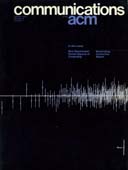January 1976 - Vol. 19 No. 1

Features
A study of line overhead in the Arpanet
The form, extent, and effect of the communication line overhead in the ARPANET are considered. The source of this overhead is separated into various levels of protocol hierarchy and the characteristics of each level are summarized. Then the line efficiency for various models of system use is studied. Some measurements of line efficiency for the ARPANET are presented and by extrapolation these measurements are used to anticipate overhead in a heavily loaded network. Similar results are derived for a recently proposed network protocol and compared with those for the current system.
A model for disk accesses based on published measurements is developed. The model is used to show that under highly probable conditions, FCFS seek scheduling is superior to SSTF scheduling in the sense of having a lower mean queue length. A simple example of an arrival sequence illustrating this anomaly is presented.
On quadratic adaptive routing algorithms
Two analytic models of a store-and-forward communications network are constructed, one to find the optimal message routing and the other to illustrate the equilibrium (stationary state) maintained by an adaptive routing algorithm. These models show that adaptive routing does not satisfy the necessary conditions for an optimal routing. Adaptive routing tends to overuse the direct path and underuse alternate routes because it does not consider the impact of its current routing decision on the future state of the network. The form of the optimality conditions suggests that a modification of the adaptive algorithm will result in optimality. The modification requires the substitution of a quadratic bias term instead of a linear one in the routing table maintained at each network node. Simulation results are presented which confirm the theoretical analysis for a simple network.
Performance of height-balanced trees
This paper presents the results of simulations that investigate the performance of height-balanced (HB[k]) trees. It is shown that the only statistic of HB[1] trees (AVL trees) that is a function of the size of the tree is the time to search for an item in the tree. For sufficiently large trees, the execution times of all procedures for maintaining HB[1] trees are independent of the size of the tree. In particular, an average of .465 restructures are required per insertion, with an average of 2.78 nodes revisited to restore the HB[1] property; an average of .214 restructures are required per deletion, with an average of 1.91 nodes revisited to restore the HB[1] property. Moreover, the execution times of procedures for maintaining HB[k] trees, for k > 1, are also independent of the size of the tree except for the average number of nodes revisited on a delete operation in order to restore the HB[k] property on traceback. The cost of maintaining HB[k] trees drops sharply as the allowable imbalance (k) increases. Both analytical and experimental results that show the cost of maintaining HB[k] trees as a function of k are discussed.
Items in business systems have to be identified by reference codes, which can later be used as data codes and file keys in an associated data processing system. In business systems associated with large collections of integrated files (databases) it is vital to assign codes in a methodical way so as to control future extension and changes while maintaining correct program action. The principles of methodical coding are discussed, and the way in which logical connections between data items must be reflected in the reference code framework is shown through a set-theoretic information model.
A study of errors, error-proneness, and error diagnosis in Cobol
This paper provides data on Cobol error frequency for correction of errors in student-oriented compilers, improvement of teaching, and changes in programming language. Cobol was studied because of economic importance, widespread usage, possible error-inducing design, and lack of research. The types of errors were identified in a pilot study; then, using the 132 error types found, 1,777 errors were classified in 1,400 runs of 73 Cobol students. Error density was high: 20 percent of the types contained 80 percent of the total frequency, which implies high potential effectiveness for software-based correction of Cobol. Surprisingly, only four high-frequency errors were error-prone, which implies minimal error inducing design. 80 percent of Cobol misspellings were classifiable in the four error categories of previous researchers, which implies that Cobol misspellings are correctable by existent algorithms. Reserved word usage was not error-prone, which implies minimal interference with usage of reserved words. Over 80 percent of error diagnosis was found to be inaccurate. Such feedback is not optimal for users, particularly for the learning user of Cobol.



